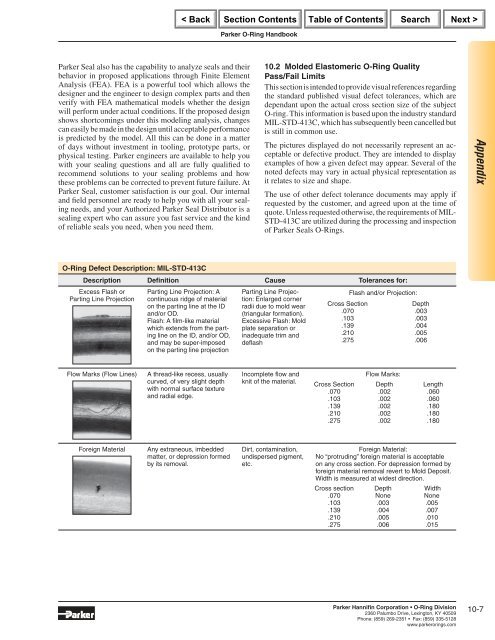Parker O-Ring Handbook.pdf
Parker O-Ring Handbook.pdf
Parker O-Ring Handbook.pdf
Create successful ePaper yourself
Turn your PDF publications into a flip-book with our unique Google optimized e-Paper software.
<strong>Parker</strong> Seal also has the capability to analyze seals and their<br />
behavior in proposed applications through Finite Element<br />
Analysis (FEA). FEA is a powerful tool which allows the<br />
designer and the engineer to design complex parts and then<br />
verify with FEA mathematical models whether the design<br />
will perform under actual conditions. If the proposed design<br />
shows shortcomings under this modeling analysis, changes<br />
can easily be made in the design until acceptable performance<br />
is predicted by the model. All this can be done in a matter<br />
of days without investment in tooling, prototype parts, or<br />
physical testing. <strong>Parker</strong> engineers are available to help you<br />
with your sealing questions and all are fully qualifi ed to<br />
recommend solutions to your sealing problems and how<br />
these problems can be corrected to prevent future failure. At<br />
<strong>Parker</strong> Seal, customer satisfaction is our goal. Our internal<br />
and fi eld personnel are ready to help you with all your sealing<br />
needs, and your Authorized <strong>Parker</strong> Seal Distributor is a<br />
sealing expert who can assure you fast service and the kind<br />
of reliable seals you need, when you need them.<br />
O-<strong>Ring</strong> Defect Description: MIL-STD-413C<br />
<strong>Parker</strong> O-<strong>Ring</strong> <strong>Handbook</strong><br />
10.2 Molded Elastomeric O-<strong>Ring</strong> Quality<br />
Pass/Fail Limits<br />
This section is intended to provide visual references regarding<br />
the standard published visual defect tolerances, which are<br />
dependant upon the actual cross section size of the subject<br />
O-ring. This information is based upon the industry standard<br />
MIL-STD-413C, which has subsequently been cancelled but<br />
is still in common use.<br />
The pictures displayed do not necessarily represent an acceptable<br />
or defective product. They are intended to display<br />
examples of how a given defect may appear. Several of the<br />
noted defects may vary in actual physical representation as<br />
it relates to size and shape.<br />
The use of other defect tolerance documents may apply if<br />
requested by the customer, and agreed upon at the time of<br />
quote. Unless requested otherwise, the requirements of MIL-<br />
STD-413C are utilized during the processing and inspection<br />
of <strong>Parker</strong> Seals O-<strong>Ring</strong>s.<br />
Description Defi nition Cause Tolerances for:<br />
Excess Flash or<br />
Parting Line Projection<br />
Parting Line Projection: A<br />
continuous ridge of material<br />
on the parting line at the ID<br />
and/or OD.<br />
Flash: A fi lm-like material<br />
which extends from the parting<br />
line on the ID, and/or OD,<br />
and may be super-imposed<br />
on the parting line projection<br />
Flow Marks (Flow Lines) A thread-like recess, usually<br />
curved, of very slight depth<br />
with normal surface texture<br />
and radial edge.<br />
Foreign Material Any extraneous, imbedded<br />
matter, or depression formed<br />
by its removal.<br />
Parting Line Projection:<br />
Enlarged corner<br />
radii due to mold wear<br />
(triangular formation).<br />
Excessive Flash: Mold<br />
plate separation or<br />
inadequate trim and<br />
defl ash<br />
Incomplete fl ow and<br />
knit of the material.<br />
Dirt, contamination,<br />
undispersed pigment,<br />
etc.<br />
Cross Section<br />
.070<br />
.103<br />
.139<br />
.210<br />
.275<br />
Cross Section<br />
.070<br />
.103<br />
.139<br />
.210<br />
.275<br />
Flash and/or Projection:<br />
Flow Marks:<br />
Depth<br />
.002<br />
.002<br />
.002<br />
.002<br />
.002<br />
Depth<br />
.003<br />
.003<br />
.004<br />
.005<br />
.006<br />
Length<br />
.060<br />
.060<br />
.180<br />
.180<br />
.180<br />
Foreign Material:<br />
No “protruding” foreign material is acceptable<br />
on any cross section. For depression formed by<br />
foreign material removal revert to Mold Deposit.<br />
Width is measured at widest direction.<br />
Cross section<br />
.070<br />
.103<br />
.139<br />
.210<br />
.275<br />
Depth<br />
None<br />
.003<br />
.004<br />
.005<br />
.006<br />
Width<br />
None<br />
.005<br />
.007<br />
.010<br />
.015<br />
<strong>Parker</strong> Hannifi n Corporation • O-<strong>Ring</strong> Division<br />
2360 Palumbo Drive, Lexington, KY 40509<br />
Phone: (859) 269-2351 Fax: (859) 335-5128<br />
www.parkerorings.com<br />
Appendix<br />
10-7

















